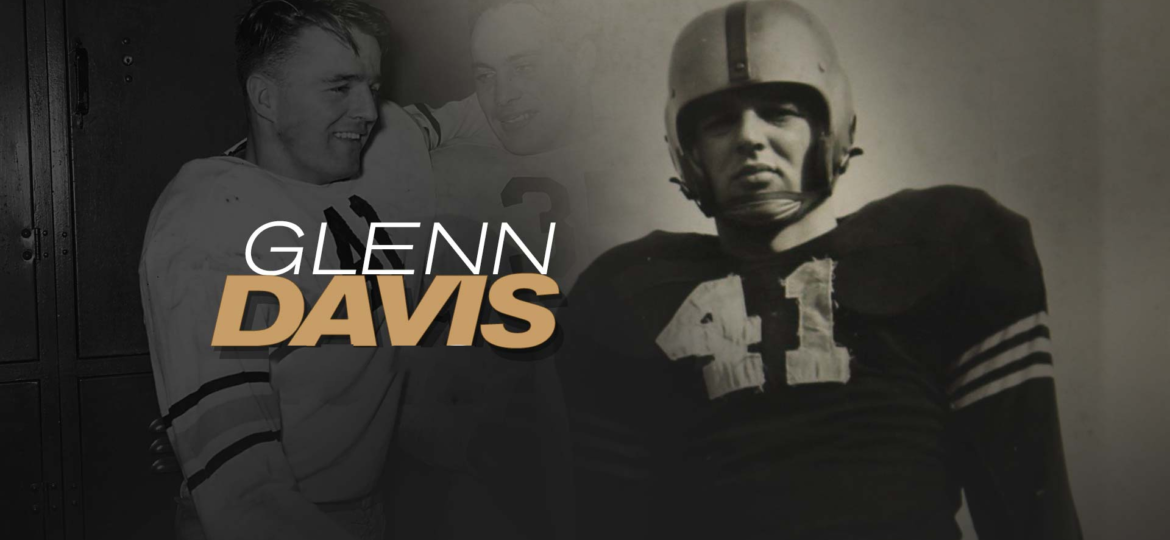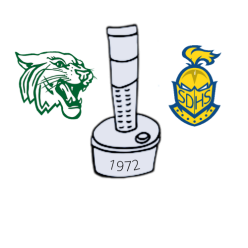
Glenn Davis, the most decorated and greatest athlete in the history of Bonita High School, graduated from the school in 1943. He was the 12th winner of the Heisman Award given to the finest collegiate football player in 1946 while playing for Army. Davis, “Mr. Outside,” ran for nearly 3,000 yards, had 850 receiving yards and even passed for 1,172 yards during his time at Army. He was drafted by the NFL’s Detroit Lions, but had to fulfill his military obligation which he did by serving in Korea until 1950. He played with the Los Angeles Rams from 1950 to 1953 participating in two Championship games. Davis led the Rams in rushing and touchdowns in 1950. In 1961 he was voted into the college Football Hall of Fame. The Bonita District Football field was named after Davis in 1986 even though the location where Davis attended high school now belongs to Damien High School in La Verne.


Glenn Davis donated his beloved Heisman Trophy to the school in 2004. (Bill Plaschke 2004 Column, “It’s Better to Give Than Receive It” describing the event won sports column of the year). “Nobody knew that he was going to give the Heisman to the school, and Glenn specifically asked for no cameras or no media coverage,” said Eric Podley, former head football coach at Bonita High School.
“I just happened to be walking outside the day he brought it. I saw a little old man and a little old woman walking along. I thought they were lost, Dan Harden, former Bonita Athletic Director said. Then I saw it. He was walking with his wife and just carrying it along, under his arm.
“We got him inside and he made sure we didn’t have a big ceremony or anything. So we went to the principal’s office and he gave it to us. And then, the most interesting thing happened. We were passing the school trophy case and he stopped and pointed to a baseball on a little stand. There were no markings on the ball. A group of community businessmen had given it to him for his baseball achievements. He knew exactly what it was.
“He asked if he could have it.”
Davis had a deep appreciation for the school that gave him his start. “Here is a guy who went far beyond Bonita High School, but never lost track of his roots. Too often, people forget where they came from, but he obviously didn’t,” said Podley.
He went on to work for the Los Angles Times Special Events department and worked there for 35 years. Davis died of prostate cancer at La Quinta, California at age 80 on March 9, 2005. He is interred in West Point Cemetery.
In 2016 during the annual Smudge pot game between San Dimas and Bonita, a football with Glenn Davis’ signature was donated to the school by former La Verne mayor Don Kendrick. Dr. Eugene St. Clair, a retired physician who was a teammate of Davis at Bonita made the formal presentation at half time.




Glenn Woodward Davis was born December 25, 1925, in Claremont, California. He was referred to as “Junior” because he was born 90 minutes after his twin brother, Ralph. Both the boys were very active and “always on the go.” They double dated together, played harmless pranks and were both fine athletes. They hung around the Bonita High School football field as ten year olds. They worked summers as fruit pickers, camp counselors in the San Bernardino Mountains and as defense workers at a plant on Olympic Boulevard in Los Angeles. While at Bonita High School, Glenn Davis played in four sports…football, baseball, basketball and track. He won 13 varsity letters (some say 16 letters because of the exponent system then in effect). While the “Smudge Pot” award is given to the winning team when Bonita plays San Dimas High School in football, during Davis’s time as a Bearcat the big rival school was Claremont High School. During the 1940’s, Bonita High School’s rally song was:

“Sock ’em in the collar button —
Hit ’em in the jaw.
Drag ’em thrugh the ceme-tery, Rah! Rah! Rah!”
Glenn Davis scored 464 points in three varsity seasons, including 236 in his senior season of 1942, leading Bonita High School to an 11-0 record and the school’s first ever football championship. The Bearcats won the CIF Southern Section Class A title in a 39 to 6 win over Newport Harbor High School and Davis scored five touchdown runs. They won their play-off games 47-0, 41-12 and 39-6. Davis scored 36 touchdowns that year, finishing his prep career with 70 touchdowns—both CIF records at the time.
In the 41-12 win over South Pasadena, Davis became a Ripley’s “Believe it or Not,” item. In Bonita’s single wing offense he threw a touchdown pass to his brother, Bonita was offside. He threw another TD pass to his brother and they were offside again. On the third play, Davis threw another TD pass. Bonita was flagged for holding. On the fourth play, from 55 yards out he faked a pass and ran it in for a touchdown. As a result he became known as the “Claremont Comet.” In 1942, he was the CIF Southern Section Player of the Year in football. He was All CIF Southern Section player in baseball that spring. He also received the the 1943 Knute Rockne Trophy as the best track star in Southern California.
Stanford Michael played center on Bonita’s Varsity football team and remembers an unusual play that Davis made. “It didn’t happen very often because most of the time nobody could touch him, but one game he got his bell rung. During the next play, he got the ball and didn’t know what to do with it; he just stood there holding it for about five seconds. When he finally came to, he took off for a 50-yard touchdown. I guess he had a good offensive line. It was a great team,” says Michael. “He got a lot of glory, but didn’t flaunt it at all. He wished they wouldn’t talk him up so much,” says Michael. Michael wrote for the school paper and remembers a time when he was interviewing Davis for an article. “Glenn wanted me to make sure that I talked about the whole team and not just him. He was a very humble person.”

During Davis’s four years at West Point, he lettered 10 times ( four in football, three in baseball, two in track and one in baseball). Davis also demonstrated his incredible athletic ability off the playing field. He still holds NCAA records for most yards gained per play in one season, averaging 11.5 yards per carry in 1945. He also holds the national career record of 8.26 yards per rushing attempt. Time magazine wrote in 1945: “Davis carries a special kind of speed that is all his own. After a brief show of hippiness, enough to get around the end, he simply leans forward and sprouts wings.” Davis’ Army coach, the legendary Earl “Red” Blaik, once declared, “Glenn Davis could do anything you asked, and he did it better than almost anyone else. He’s the best halfback I’ve ever seen.”
With his speed, track probably would have been Davis’ best sport, had he concentrated on it. In 1947, he ran a 6.1-second 60-yard dash at Madison Square Garden, beating Barney Ewell, who the next year won the silver medal in the 100 meters at the London Olympics.

The track story everyone likes to tell about Davis occurred later that spring, after an Army-Navy baseball game. Davis played nine innings in center field, getting, as he later recalled, “a couple of hits,” then, although he had not run an outdoor meet that season, was rushed to the track because Army was short of sprinters. In borrowed shoes, he won the 100-yard dash in 9.7 seconds, then later won the 220 in academy-record time, 20.9.
Ron Fimrite, in a 1988 article for Sport Illustrated shared the following story about Davis:
In his time, cadets were required to take a physical-fitness test that included such events as the rope climb, the 300-yard run the bar vault, the vertical jump, the standing long jump and the softball throw, as well as chin-ups and push-ups. A perfect score was 1,000 points. Before Davis the record score was 901½ points and the average for all cadets, not quite 550. Davis scored an unheard-of 962½.


As good an athlete as he was, however, Davis was no whiz as a student. He graduated 305th in a class of 310 and mathematics nearly did him in during his first term at the Point. It was 1943, the war was raging and officers were in critical demand, so at the academy, courses were accelerated. Cadets were expected to do four years’ work in two or three – and athletes caught no breaks. Davis, who that season rushed for 1,028 yards, took to getting up at 4 a.m. to have 90 minutes of study time before reveille, but still flunked his math course.
“I just couldn’t do it all,” he told Sports Illustrated in 1988. “I was taking five classes every day. I’d get out of the last one at 3:30 and be on the football field at 4. I wouldn’t get home until 6:30, then I’d have dinner and study.”
So in December, he was sent home, with instructions to study hard, make up his deficiencies and apply for reappointment in 1944. Davis went back to California and completed an intensive four month math course (some sources say at Webb School but recent evidence suggest Pomona College) and was readmitted back to the academy as a plebe.
Glenn did not consider the first year at Army his greatest moment so he did not discuss it with his family. Kathryn Davis, the 94 year old sister-in-law, who was married to Ralph provided some clarity about this difficult time for Glenn in a recent email exchange quoted below.
“Being ‘sent back’ is not really a great rarity at West Point. The term they use is being ‘Found’. They have a very tough entrance exam to prevent too many applicants from finding themselves in such a situation. It is not unusual to find some cadets have already had a year or two at another college or university before they come to West Point. But, here was Glenn – fresh out of high school and then he was entered into a very arduous military college environment, plus exceptional time had to be devoted to the new regimen for college football practice and difficulty began with the concentrated math classes. Upon entrance to West Point, all students are sworn into the army. Therefore those who ‘hit a bump’ like this in their career are still under army control and work out their reentry requirements as directed by the Academy. Some, decide not to continue. Glenn was well known by the college Community at Pomona College ‘next door’ to his family home. As I recall, whatever tutoring was required was set up through Pomona College which was noted for excellent tutorial access. With this completed, Glenn was able to reenter West Point and start the first year again.”
He played with the Los Angeles Rams from 1950 to 1953 participating in two Championship games; Davis led the Rams in
rushing and touchdowns in 1950. He had injured his knee (tore cartilage and ligaments in his right knee) while filming the 1946 movie, “The Spirit of West Point,” on the UCLA practice field and the injury recurred in 1951. He said that in his last years of professional football he was a better physical player in high school due to his injuries.
Glen Davis dated actress Ann Blyth and Elizabeth Taylor. He was married briefly to actress Terry Moore and to Ellen Harriet Lancaster Slack for 43 years until her death. His last wife was Yvonne, who interestingly enough was married to another Heisman Trophy winner Alan Ameche, the great University of Wisconsin and Baltimore Colts running back.
Sources
‘Emphatically the greatest halfback’ of all time played just one year in the NFL.”Associated Press, March 12, 2005.http://www.granburydepot.org/z/biog2/DavisGlenn.htm

